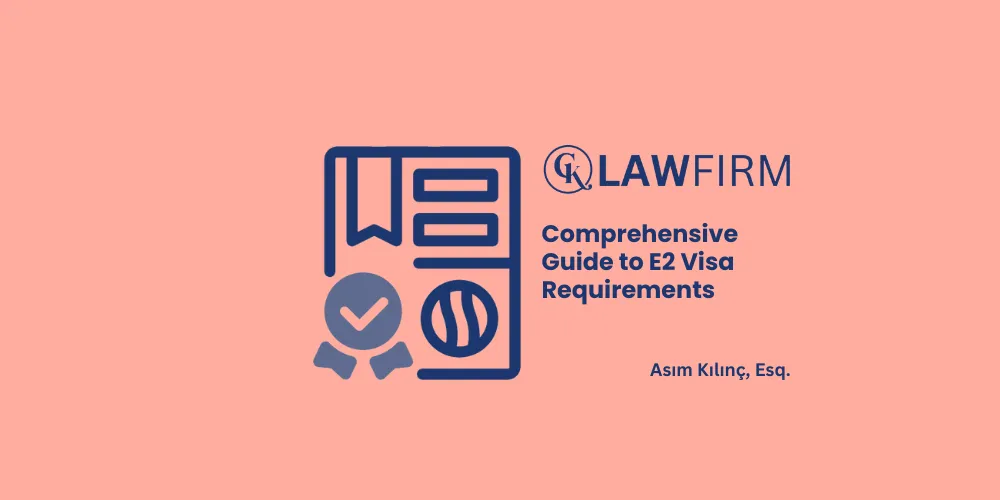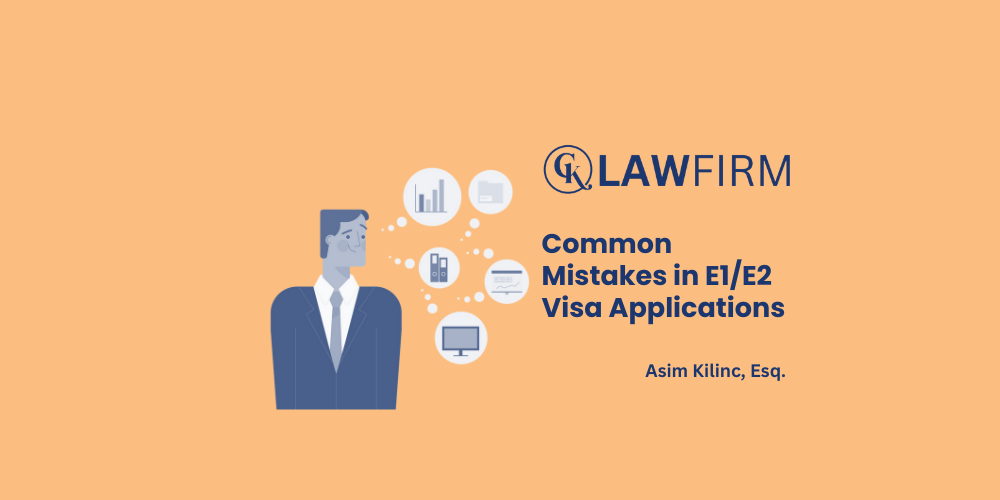Schedule an Appointment with Our Attorneys Now
Asım Kılınç, Immigration Attorney, CK Law Firm
Are you considering starting a business in the United States? The E2 visa provides an exceptional opportunity for entrepreneurs and investors from treaty countries to live and work in the U.S. In this comprehensive guide, we’ll address the most frequently asked questions about the E2 Investor Visa, including its E2 visa requirements, benefits, and challenges. Whether you’re looking to invest in an existing business or start a new one, this blog has you covered. In this article, the topics I will touch upon with the E2 investor visa conditions are as follows:
- What are the E2 Investor Visa Requirements?
- What is the Lowest Investment for an E2 Visa?
- E2 Visa to Green Card
- What is the Approval Rate for the E2 Visa?
While answering these questions, I will also address the sub-headings that are curious. However, as in every visa application, you can contact us via the official website of CK Law Firm to get support from us in E2 visa application. You can also always reach me on my LinkedIn account.
What are the E2 Investor Visa Requirements?
The USCIS outlines 9 criteria to qualify for the E2 visa. These criteria ensure that applicants contribute to the U.S. economy through substantial and active investments. Below is a detailed explanation of these criteria:
- Nationality: Applicants must be citizens of a country with which the U.S. maintains a treaty of commerce and navigation. The list of eligible countries can be found on the USCIS website.
- Substantial Investment: The investment amount must be significant in relation to the total cost of the business. While there is no fixed minimum, most applicants invest between $100,000 and $200,000.
- Investment at Risk: The funds must be committed and subject to partial or total loss if the business does not succeed. Passive investments, such as real estate purchases, do not qualify.
- Active Business Operations: The investment must be directed toward an active, for-profit enterprise. Passive income-generating investments, such as stock portfolios, are not eligible.
- Ownership and Control: The applicant must own at least 50% of the enterprise or possess operational control through a managerial position or other means.
- Marginality: The business cannot be marginal, meaning it must generate more than enough income to support the investor and their family or create significant economic impact through job creation.
- Intent to Depart: Applicants must demonstrate an intent to leave the U.S. when their E2 status ends. The visa does not lead to permanent residency automatically.
- Legal Source of Funds: The investment capital must be lawfully acquired and traceable. This ensures the legitimacy of the financial resources used.
- Job Creation: While not explicitly required, businesses that create jobs for U.S. workers are more likely to receive favorable consideration.
These criteria are crucial for ensuring that the E2 investor visa program supports the U.S. economy while providing opportunities for qualified investors.
Who Qualifies for an E2 Visa?
To qualify for the E2 visa, applicants must meet these criteria:
- Be a national of a treaty country.
- Have committed or be in the process of committing the required investment.
- Demonstrate that the business is not marginal and will generate enough income to support the investor and their family.
What are the Disadvantages of an E2 Visa?
Despite its many advantages, the E2 visa has some limitations:
- Non-Immigrant Status: It doesn’t directly lead to a Green Card.
- Renewal Dependence: The visa must be renewed periodically, and approval is contingent on the business remaining active.
- Limited Nationality Eligibility: Only nationals of treaty countries can apply.
- Restricted Pathways: Transitioning from an E2 visa to a Green Card often requires additional investment or employer sponsorship.
E2 Visa to Green Card
While the E2 visa doesn’t offer a direct path to permanent residency, it can be a stepping stone. Popular routes include:
- EB-5 Investor Visa: Transition by increasing your investment to meet EB-5 requirements.
- Employment-Based Green Cards: Seek sponsorship through employment or business growth.
What is the Lowest Investment for an E2 Visa?
While the E2 visa doesn’t have a fixed minimum investment amount, successful applications typically involve at least $100,000. However, smaller investments may be acceptable if they are substantial enough to cover the costs of the business and ensure its success.
- E2 Visa Businesses for Sale: Buying an established business is a popular option for investors, as it often simplifies the application process and ensures immediate economic impact.
What is the Approval Rate for the E2 Visa?
The E2 visa approval rate is relatively high, often exceeding 85% globally. Approval depends on the completeness of your application, the viability of your business plan, and compliance with all USCIS requirements.
Related Visas: Comparing E1, E2, and M1 Visas
- E1 Visa: Focused on trade between treaty countries and the U.S.
- E2 Manager Visa: For managerial employees of businesses owned by E2 investors.
- M1 Visa Requirements: Designed for vocational or non-academic students, not related to investment.
Yes, we have come to the end of a curious topic. I should mention again that getting support in visa applications is important for the smooth and fast progress of the process. At this point, you can always contact us through our website or through my LinkedIn account to get support from me. You can also always ask us any questions you may have by adding your questions in the comments section of this blog.

By Ozlem Kara, Content Editor at CK Law Firm
In 2024, 230 immigrant-founded companies generated $8.6 trillion in revenue!
Nearly 46% of the largest revenue-generating companies in the U.S. were founded by immigrants or their children, marking a new high in the impact of immigrants on American business, according to a 2024 report from the American Immigration Council. The report highlights that nearly half of the Fortune 500 companies have roots in immigrant entrepreneurship, underscoring the substantial contribution of immigrants to the U.S. economy.
Since 2011, the American Immigration Council has tracked the influence of immigrant entrepreneurs through Fortune Magazine’s annual list of the top 500 companies by revenue. The 2024 report, titled “New American Fortune 500: The Largest American Companies and Their Immigrant Roots,” indicates that the number of immigrant-founded businesses has reached 46% this year, with 10 new companies such as DoorDash and EchoStar making their debut on the list.
In 2023, the 230 immigrant-founded companies generated a combined $8.6 trillion in revenue—greater than the GDP of many nations. These companies also employed more than 15.5 million people worldwide, showing the far-reaching economic influence of immigrants in creating jobs both within and outside the U.S. “This report demonstrates how immigrants are critical to economic growth, job creation, and maintaining the U.S. as a global economic leader,” said Nan Wu, Director of Research at the American Immigration Council. “Our economy is stronger and more dynamic because of the immigrants who have built businesses here.”
The report also analyzes the states with the highest number of immigrant-founded companies in the Fortune 500. New York leads with 32 companies, followed by California with 28. These businesses play a vital role in their local economies, often forming a significant portion of a state’s total economic output.
By Ergul Celiksoy, Immigration Attorney at CK Law Firm
As a Green Card (Permanent Resident Card) holder, you enjoy many rights and privileges in the United States. However, to protect these rights and maintain your legal status, it is crucial to follow specific rules and timeframes. The key to keeping your Green Card is to demonstrate the intent to reside permanently in the U.S. and return regularly within specified time limits. In this post, we’ll detail the important timeframes and conditions Green Card holders must follow to maintain their permanent resident status.
- Requirement to Maintain Intent to Reside Permanently in the United States
- Re-entry Permit
- Physical Presence Requirement in the US
- Obligation to file a tax return
- Green Card Renewal and Expired Cards
- Timeframes for Citizenship
- Address Notification Requirement
- Returning Resident Visa (SB-1 Visa)
If you have any questions beyond what is covered here, feel free to contact me via LinkedIn, the comments section of this post, or through the CK Law Firm website, where I am a co-founder.
1. Requirement to Maintain Intent to Reside Permanently in the U.S.
Having a Green Card gives you the legal right to live and work in the U.S., but staying outside the U.S. for an extended period can jeopardize this right. The U.S. government expects Green Card holders to live permanently in the U.S. If you stay outside the U.S. for more than six months, it may raise questions about your intent to reside in the U.S. If you remain outside the U.S. for more than six months but less than one year, this can lead to questions at the border about whether you have abandoned your permanent resident status. Staying outside the U.S. for more than one year puts your permanent resident status at significant risk.
If you remain outside the U.S. for more than two years, the chances of losing your Green Card increase significantly, and you may need to reapply for a new Green Card to re-enter the U.S.
2. Reentry Permit
If you need to stay outside the U.S. for an extended period (e.g., for work, education, or family reasons), it is recommended that you apply for a Reentry Permit from USCIS before your departure. This document allows you to remain outside the U.S. for up to two years while maintaining your intent to reside permanently. Applying for a Reentry Permit is highly advantageous in preserving your Green Card upon your return. However, even with this permit, you must maintain your ties to the U.S. during your absence.
3. Physical Presence in the U.S. Requirement
Green Card holders are expected to physically reside in the U.S. If you spend extended periods outside the U.S. without being physically present, U.S. Customs and Border Protection (CBP) officers may determine that you no longer intend to reside permanently in the U.S. To maintain your Green Card, you should maintain a U.S. address, employment, and file taxes. Simply entering and exiting the U.S. is not sufficient to meet this requirement.
Even for trips less than one year, you may need to prove your intent to reside permanently when you return. It is essential to keep strong ties to the U.S., such as maintaining an address or job and filing tax returns.
4. Tax Filing Obligation
Green Card holders must file taxes annually during their time in the U.S. Even if you live outside the U.S., you remain a U.S. taxpayer, and you must file a return regardless of your income. Failure to file taxes or claiming tax residency in another country can jeopardize your permanent resident status. Filing taxes with the IRS on time and accurately demonstrates compliance with your legal obligations and helps protect your status.
5. Green Card Renewal and Expired Cards
Green Cards are generally valid for ten years, and you must renew them before they expire. Even if your Green Card has expired, you do not lose your status, but it may cause difficulties when traveling or working. To renew your Green Card, you need to submit Form I-90 to USCIS. Expired Green Cards can create complications, particularly when traveling or seeking employment, so it’s essential to renew them promptly.
Conditional Green Card holders must be aware that their cards expire after two years. Before this expiration, they must apply for a permanent Green Card, or they risk losing their status.
6. Timeframes for Citizenship
Green Card holders who wish to become U.S. citizens must maintain permanent residence in the U.S. for a specific period. Generally, you must be a permanent resident for five years to apply for citizenship. However, if you are married to a U.S. citizen, this period is reduced to three years. Before applying, you must also have spent a certain amount of time physically in the U.S. Being outside the U.S. for more than 30 months during this time can negatively affect your citizenship application. It’s also essential to have a continuous U.S. address and maintain strong ties to the country when applying.
7. Address Reporting Requirement
Green Card holders are required to notify USCIS if they change their address. If you move within the U.S., you must notify USCIS of your new address within ten days. Failing to do so can lead to serious consequences and may result in the loss of your permanent resident status.
8. Returning Resident Visa (SB-1 Visa)
If you stay outside the U.S. for more than one year without a Reentry Permit and lose your Green Card, you may need to apply for an SB-1 (Returning Resident) Visa to return to the U.S. This visa helps you regain your permanent resident status, but the process can be time-consuming and challenging. U.S. consulates carefully review SB-1 visa applications, and you must prove your intent to reside permanently in the U.S.
Conclusion
Maintaining your Green Card status involves following essential timeframes and conditions. Staying outside the U.S. for long periods can put your permanent resident status at risk. When making travel plans, it is vital to obtain the necessary permits and maintain strong ties to the U.S. Renewing your Green Card before it expires, filing taxes correctly, and reporting your U.S. address are crucial obligations.
CK Law Firm provides professional guidance on how to maintain your legal status in the U.S. as a Green Card holder and advises on the timeframes required for citizenship applications. If you have questions about maintaining your Green Card, it’s advisable to consult an immigration attorney. For more information and consultations, please contact us at cklawfirm.org, via email at info@cklawfirm.org, or reach out through LinkedIn.
Who is Attorney Ergül Çeliksoy?
Attorney Dr. Ergül Çeliksoy is a founding partner of CK Law Firm and also serves as an Assistant Professor of Law at the University of Nottingham. With extensive experience in U.S. immigration law, Dr. Çeliksoy completed a Master’s degree in international law and human rights law at the University of Nottingham in 2017, followed by a Ph.D. at the same university. His Ph.D., completed in 2022 at the University of Nottingham School of Law, marked a significant milestone in his academic career. Dr. Çeliksoy has published extensively in leading academic journals and is internationally recognized for his expertise in modern slavery, criminal justice, and criminal law. As a member of the California Bar, Dr. Çeliksoy offers exceptional service to his clients, particularly in U.S. immigration law cases. His expertise and experience in immigration law significantly contribute to CK Law Firm’s work in this area.
Dr. Çeliksoy provides comprehensive and strategic solutions to his clients in immigration law cases, helping secure their legal status in the U.S. His work on human rights and immigration processes, particularly in modern slavery and criminal law, effectively addresses the complex legal issues immigrants face. Dr. Çeliksoy reinforces CK Law Firm’s leadership in immigration law by offering reliable and effective legal consulting services to his clients, helping them build new lives in the United States.
By Ergul Celiksoy, Immigration Attorney at CK Law Firm
Applying for a Green Card through marriage is one of the most common pathways for family-based immigration to the United States. If you are married to a U.S. citizen or a Green Card holder, you may qualify for lawful permanent residency. In this guide, we will walk you through the step-by-step process and provide important insights to help you navigate the system efficiently. Let’s talk about the questions I will address in this article:
- How to Obtain a Green Card Through Family?
- When Will You Receive Your Green Card After Marriage?
- Can a Spouse Benefit from a Green Card?
- How Much Does a Green Card Application Cost in 2025?
- Applying for a Green Card While in the U.S.
If you are planning to get a Green Card but don’t know how to apply, you can contact us on our website or in the comments section of our blog. You can also send me a message on LinkedIn for private communication.
How to Obtain a Green Card Through Family?
If your spouse is a U.S. citizen or a Green Card holder, they can sponsor your application to become a lawful permanent resident. Here are the steps involved in the process:
- Filing Form I-130 (Petition for Alien Relative): Your U.S. citizen or Green Card holder spouse must file this form with the U.S. Citizenship and Immigration Services (USCIS). This step establishes the legitimacy of your marriage. Supporting documents, such as your marriage certificate, joint financial records, and photos, should be included.
- Filing Form I-485 (Adjustment of Status): If you are in the United States on a valid visa, you may file Form I-485 to adjust your status to permanent residency. This form is often used for those already legally residing in the U.S. Temporary work and travel authorization can also be granted during this process.
- Providing Supporting Evidence: USCIS requires proof that your marriage is genuine. This can include joint tax returns, shared lease agreements, photos from your wedding, and letters from family and friends attesting to your relationship.
- Attending the Marriage-Based Green Card Interview: Both you and your spouse will be required to attend an interview with a USCIS officer. The officer will ask questions to verify the authenticity of your relationship. Be prepared to discuss your shared life and provide additional documentation if requested.
- USCIS Decision: After reviewing your application, evidence, and interview results, USCIS will determine whether to approve your Green Card application. If approved, you will receive your Green Card and become a lawful permanent resident.
When Will You Receive Your Green Card After Marriage?
The timeline for obtaining a marriage-based Green Card varies depending on your spouse’s status and your location. Typically:
- If your spouse is a U.S. citizen: The process takes approximately 10-13 months.
- If your spouse is a Green Card holder: The waiting period may extend to 2-3 years due to visa quotas.
Processing times also depend on the USCIS service center handling your case. Providing accurate and complete documentation can help avoid unnecessary delays.
Can a Spouse Benefit from a Green Card?
Yes, spouses of Green Card holders can apply for a Green Card under the F2A visa category. This category is specifically reserved for spouses and unmarried children of permanent residents. However, the application may take longer due to annual visa caps.
If your spouse is a U.S. citizen, your application is not subject to these limits, and the process is usually faster.

How Much Does a Green Card Application Cost in 2025?
The cost of applying for a marriage-based Green Card includes the following fees (as of 2025):
- Form I-130 (Petition for Foreign Relative): $625 (online filing) or $675 (paper filing). This form is filled out for a US citizen or Green Card holder to bring their spouse to the United States. The online application offers a faster and easier method, while the paper application is a traditional option. Processing and finalization of the application takes place within the timeframes set by USCIS.
- Form I-485 (Application for Adjustment of Status): $1,440 (including fingerprint processing fee). This form is completed if the applicant is lawfully present in the US.
- Form I-765 (Application for Work Authorization): $260. This fee is charged to provide the applicant with temporary work authorization. This voluntary application is usually preferred by individuals who are in the process of changing status. The work permit allows the applicant to work legally until the Green Card process is finalized.
- Medical Examination Fees: $300-$500 (varies by provider)
Additional costs may include:
- Attorney Fees: $2,000-$5,000, depending on the complexity of your case.
- Translation and Certification Fees: $100-$300
- Travel Expenses: Costs for attending interviews or medical appointments.
It is essential to check the most recent fee schedule on the USCIS website to ensure accurate budgeting.
Applying for a Green Card While in the U.S.
If you are legally residing in the U.S. on a visa (e.g., tourist or student visa), you can adjust your status after marriage to a U.S. citizen. Key points to consider:
- Avoid visa overstays or unauthorized employment, as these can complicate your application.
- Submit complete and accurate documentation to minimize processing delays.
- You may be eligible for temporary work authorization while your application is pending.
Marriage After Receiving a Green Card
If you marry after obtaining a Green Card, you can sponsor your spouse for immigration to the U.S. through the F2A category. However, this process may take longer due to visa quotas. It is crucial to provide substantial evidence of your relationship, such as shared finances, photos, and correspondence, to demonstrate the marriage’s authenticity.
Green Card application through marriage can be completed successfully by paying attention to the correct documents and details. You can always contact us via our website for assistance in this process. You can also contact me on LinkedIn for your specific questions.

By Asim Kilinc, Immigration Attorney at CK Law Firm
E1 and E2 visas offer significant opportunities for entrepreneurs wishing to engage in trade or make investments in the United States. However, the application process for these visas can be complex, and mistakes made by applicants can lead to delays or even denials. In this article, we will thoroughly examine the most common mistakes made when applying for E1 and E2 visas and explain how to avoid them. By using this information, you can strengthen your application and increase your chances of success.
- What Are E1 and E2 Visas?
- Providing Incomplete or Incorrect Documents
- Insufficient Investment Amount
- Submitting a Weak Business Plan
- Using Personal Income for the Investment
- Misunderstanding Visa Types and Requirements
- Failing to Manage Visa Status Correctly
- Overlooking the Application Process for Family Members
If you have further questions on this topic, feel free to leave a comment below this article, send me a message directly via LinkedIn, or reach out through the website of CK Law Firm, where I am a co-founder!
What Are E1 and E2 Visas?
- E1 Visa is a trade visa granted to nationals of countries that maintain substantial trade with the United States. Applicants must provide evidence of significant trade with the U.S.
- E2 Visa is for investors who make a significant capital investment in the U.S. It is suitable for entrepreneurs who want to start a business or take over an existing one.
Both visa types offer significant opportunities for businesspeople looking to trade or invest in the U.S., but mistakes made during the application process can lead to serious issues.
Here are the most common mistakes encountered in E1 and E2 visa applications:
1. Providing Incomplete or Incorrect Documents
One of the most common mistakes during the application process is submitting incomplete or incorrect documents. E1 and E2 visa applications require meticulous and detailed documentation. For instance, applicants for the E1 visa must prove that they conduct regular and substantial trade with the U.S. Meanwhile, E2 visa applicants need to present evidence that their investment is “substantial.”
- For the E1 visa, you must provide documents such as trade invoices, shipping documents, and agreements with your U.S. trade partners to substantiate your trade volume.
- For the E2 visa, you need to provide documentation on the size of the investment, the source of the funds, your business plan, and how the investment will contribute to the U.S. economy. Submitting incomplete or incorrect documents can delay or even result in the rejection of your application.
Tips:
- Ensure that all documents are complete.
- Carefully review the official guidelines provided by the U.S. government to make sure that your documents are current.
2. Insufficient Investment Amount
For E2 visa applications, the investment must be deemed “substantial.” However, many applicants misjudge the required investment amount and apply with insufficient funds. If the U.S. government determines that the investment is not large enough to benefit the U.S. economy, the application may be denied.
- The concept of substantial investment varies depending on the type and needs of the business. For example, opening a large factory will require a higher investment, whereas a smaller business might require less. However, you must ensure that the investment is sufficient to meet the needs of the business.
Tips:
- Determine your investment amount based on the actual needs and sustainability of the business. Be detailed in your business plan, explaining every financial item.
- Consider the industry requirements and how your investment will benefit the U.S. economy.
3. Submitting a Weak Business Plan
For E2 visa applicants, the business plan plays a crucial role in the approval process. Many applicants are denied because they fail to provide a sufficiently detailed business plan. The plan must demonstrate that the investment is sustainable and that it will contribute to the U.S. economy. Visa officers want to see that the business will succeed in the long run.
- The business plan should include financial projections, staffing needs, growth strategies, and market analysis. A superficial or inadequate business plan can lead to the denial of your application.
Tips:
- Detail every aspect of your business in the plan, especially focusing on financial projections and job creation in the U.S.
- Have your business plan reviewed by an expert and ensure that it complies with U.S. legal requirements.
4. Using Personal Income for the Investment
Many applicants apply for an E2 visa using only personal income. However, the U.S. government often does not consider personal income sufficient. The investment must be based on a broader financial base to support the sustainability and growth of the business.
- The structure of your investment must meet the needs of the business to ensure a positive outcome for your application.
Tips:
- Ensure that your investment contributes to the growth and sustainability of the business.
5. Misunderstanding Visa Types and Requirements
One of the most common mistakes is applying for the wrong visa due to a misunderstanding of the differences between E1 and E2 visas. The E1 visa is for nationals of countries that engage in trade with the U.S., while the E2 visa is for those who wish to invest in the U.S. Not understanding the key differences between these visas can lead to a denial.
Tips:
- Understand which visa type is suitable for your situation before applying.
- Carefully analyze whether you meet the requirements for both visa types.
6. Failing to Manage Visa Status Correctly
E1 and E2 visas are typically temporary, meaning you cannot stay in the U.S. indefinitely. However, many applicants mistakenly believe that these visas lead to permanent residency (Green Card) and develop incorrect strategies. Since these visas do not provide permanent residency, you need to take the correct steps to extend or renew your stay.
Tips:
- Keep track of your visa expiration date and apply for extensions on time.
- Consider other paths to permanent residency, remembering that this process is separate from E1/E2 visas.
7. Overlooking the Application Process for Family Members
E1 and E2 visa holders’ spouses and children under 21 also have the right to live in the U.S. However, there are separate application processes for these family members. Many applicants overlook this process, leading to complications for their family members.
Tips:
- Remember that separate applications are required for your spouse and children.
- Prepare all necessary documents accurately and completely for family members’ applications.
Conclusion
E1 and E2 visas provide valuable opportunities for those looking to trade or invest in the U.S. However, mistakes during the application process can have serious consequences and lead to visa denial. By avoiding the common errors listed above, you can strengthen your application and secure your opportunity to do business in the U.S. Submitting the correct documentation, preparing a comprehensive business plan, and managing your visa status properly will increase your chances of success. For more information and consultancy services, feel free to reach out to us via our website at cklawfirm.org, by email at info@cklawfirm.org, or through LinkedIn.
Who is Attorney Asım Kılınç?
Attorney Asım Kılınç is the co-founder of CK Law Firm and is recognized for his expertise in immigration law and U.S. asylum applications. Kılınç completed his Master’s degree at Southern Methodist University Dedman School of Law and is a member of the Missouri Bar Association, with a focus on U.S. immigration law.
Attorney Kılınç’s extensive knowledge and experience in immigration law have significantly contributed to CK Law Firm’s success in this field. He has actively participated in the preparation of over 1,000 cases, demonstrating his expertise in this area. By providing comprehensive and professional legal support to his clients, he helps them adapt to their new lives in the U.S.
Attorney Kılınç is also well-versed in U.S. asylum applications. He meticulously guides his clients through the process and ensures they receive the best legal advice. He provides top-quality service to clients in matters of citizenship, Green Card, work permits, and other immigration processes, supporting them from start to finish on their journey to U.S. citizenship.
Attorney Asım Kılınç, who solidifies CK Law Firm’s leadership in immigration law and U.S. asylum applications, offers reliable and effective legal consultancy services to clients, assisting them in building a new life in the U.S.
By Asim Kilinc, Immigration Attorney at CK Law Firm
For many non-immigrants in the U.S., the need to extend or change their visa status arises due to various reasons, such as prolonged studies, new employment opportunities, or unexpected personal circumstances. Navigating the process of extending or changing your non-immigrant status can be complex and requires careful attention to detail. This guide provides detailed information on how to extend or change your visa status while in the U.S., ensuring compliance with immigration laws and regulations.
Understanding Non-Immigrant Status
Non-immigrant visas are temporary visas granted for specific purposes, such as tourism, business, study, or work. Common non-immigrant visa categories include:
- B-1/B-2: Business and tourist visas
- F-1: Student visas
- H-1B: Specialty occupation worker visas
- J-1: Exchange visitor visas
- L-1: Intra-company transferee visas
Reasons to Extend or Change Your Status
1. Extend Your Stay
- You may need to stay longer than initially planned due to extended studies, continued employment, or personal reasons.
2. Change Your Purpose of Stay
- Your initial reason for visiting the U.S. might change, such as transitioning from a student to a worker or switching from a tourist visa to a student visa.
Step-by-Step Guide to Extending or Changing Your Status
Step 1: Determine Eligibility
Eligibility for Extension
- You must be lawfully admitted into the U.S. with a non-immigrant visa.
- Your visa status must still be valid.
- You have not committed any crimes that make you ineligible.
- You have not violated the conditions of your admission.
Eligibility for Change of Status
- You must meet the eligibility criteria for the new visa category you are applying for.
- You must be lawfully present in the U.S. at the time of application.
- You must not have engaged in unauthorized employment.
Step 2: File the Appropriate Form
For Extension of Stay
- Form I-539: Application to Extend/Change Non-immigrant Status.
- Supporting Documents: Include a copy of your I-94 Arrival/Departure Record, evidence of financial support, and a letter explaining the reason for the extension.
Example: Jane, an F-1 student, needed to extend her stay to complete her degree. We filed Form I-539 with her I-94, proof of continued enrollment, and financial support documents.
For Change of Status
- Form I-539: Used for most status changes.
- Form I-129: Petition for a Non-immigrant Worker, used if you are changing to a work visa like H-1B.
- Supporting Documents: Varies based on the new status, including proof of eligibility for the new status, current I-94, and a letter explaining the change.
Example: Ahmed, on a B-2 tourist visa, decided to pursue a degree. We filed Form I-539, including his I-94, acceptance letter from the university, and proof of financial support.
Step 3: Gather Supporting Documents
Ensure you have all necessary documents to support your application:
- Proof of Financial Support: Bank statements, affidavits of support.
- Proof of Continuous Residence: Lease agreements, utility bills.
- Evidence of Ties to Home Country: To demonstrate intent to return after the temporary stay.
- Employer’s Letter: If changing to a work visa, include a job offer letter and employment verification.
Step 4: Submit Your Application
- Filing: Submit your completed form and supporting documents to USCIS before your current status expires.
- Fee: Pay the required filing fee. Check the USCIS website for the most current fee information.
Example: Sarah, transitioning from an F-1 student visa to an H-1B work visa, needed to file Form I-129. We included her I-94, job offer letter, and proof of her degree completion.
Step 5: Attend Biometrics Appointment (if required)
- Notice: You may receive a notice for a biometrics appointment.
- Appointment: Attend the appointment to have your fingerprints, photo, and signature taken.
Step 6: Wait for USCIS Decision
- Processing Time: USCIS will review your application, which can take several months.
- Stay Informed: Check the status of your application online using the USCIS Case Status tool.
Example: David, an L-1 visa holder, applied to extend his stay. We monitored the case status online and kept him informed throughout the process.
Special Considerations
1. Travel Restrictions
- Avoid international travel while your application is pending, as leaving the U.S. can be considered an abandonment of your application.
2. Overstay Consequences
- Staying beyond your authorized period without filing for an extension or change can result in being out of status, which can affect future immigration benefits.
3. Premium Processing
- For certain visa categories, premium processing is available for an additional fee, expediting the decision-making process.
Conclusion
Extending or changing your non-immigrant status in the U.S. requires careful planning and attention to detail. By following the steps outlined in this guide and seeking the assistance of an experienced immigration attorney, you can navigate the process smoothly and increase your chances of a successful outcome. At CK Law Firm, we are dedicated to providing expert legal support tailored to your unique situation. Contact us today to discuss your immigration needs and explore how we can help you achieve your goals.
Subscribe to Our Newsletter
Subscribe to our newsletter to stay informed about the latest announcements and articles written by our attorneys on U.S. immigration processes.
Sobre Nosotros
Contáctanos
+1 (945) 527- 23 22
Correo electrónico
info@cklawfirm.org
Dirección
2800 Regal Rd #102, Plano, TX 75075

All Rights Reserved by CK Law Firm.







